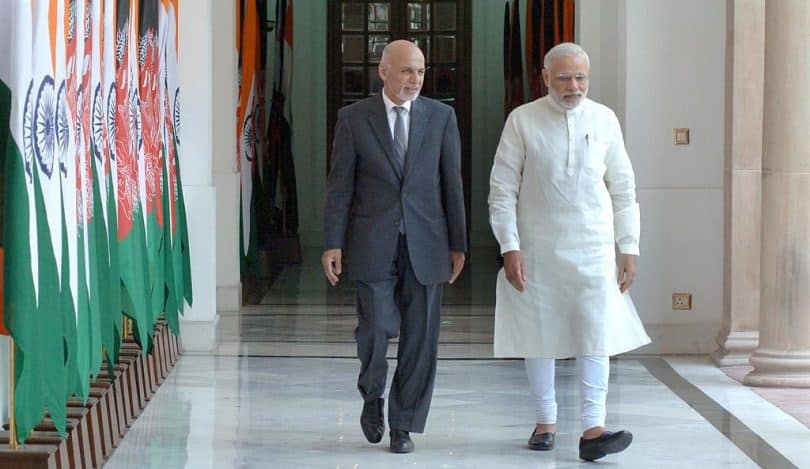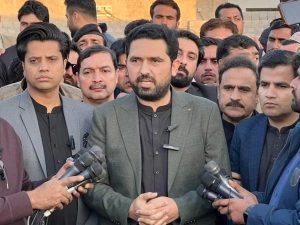ISLAMABAD – The unholy nexus between Afghanistan and India against Pakistan was visible for quite a long period of time but a recent spree of attacks including the most recent one in Quetta and Parachinar has added weight to the notion that Pakistan was being targeted by Indo-Afghan regimes harnessing the notorious ISIS-K group.
As terror revisited Pakistan on Friday with twin bombings in Parachinar, a blast in Quetta and killing of police officers in Karachi that left 60 people dead jointly, the notorious ISIS-K ( Islamic State-Khorasan province) claimed responsibility for wrecking havoc in the country. However, political analysts posed a conundrum: How can ISIS-K carry out such devastation without the help of local groups or Pakistan’s neighbours?
The answer to the question apparently came just a day before the spree of attacks that Afghan air force mysteriously dropped supplies at an area recently taken by ISIS in the north of Afghanistan.
The mysterious supply that was surely aimed at bolstering the militant group sporadically targeting Pakistan was confirmed by the locals in Afghanistan to Voice of America Dari Afghan (VOA Dari).
Moreover, the popular perception regarding the role of Afghanistan in carrying out subversive activities across Pakistan becomes closer to reality as the suicide bomber that ripped himself in Quetta was identified as Abu Usman Khurasani – an Afghan national.
It is not just Pakistan raising questions about why the militant outfit ISIS-K was being aided by Afghanistan. The Russian foreign ministry was also baffled at the airdrops and it took notice of the activity.
A statement issued by the Russian Foreign Ministry spokesperson Maria Zakharova confirmed that Afghan, U.S. and NATO officials were asked to provide a “rational explanation” about reports of unidentified helicopters providing support to ISIS-K militants in Afghanistan.
“We’ve taken note of new reports about unmarked helicopters ferrying the fighters of ISIS Afghan branch, as well as weapons and munitions for them, in eastern Afghanistan,” said Maria Zakharova during a press briefing on Wednesday.
“Some reports say that shortly before this, unmarked helicopters delivered over 50 armed extremists to reinforce the fighters who were preparing an offensive on Tora Bora, as well as a container full of weapons and munitions,” she added blowing the lid off ostensible Afghan efforts to wipe out terrorism.

It must be mentioned that most of the leadership of Tehreek-e-Taliban was enrolling itself in ISIS-K to strengthen it against their former outfit and to destabilise Pakistan, currently revamping its economy through the multi-billion dollars China-Pakistan Economic Corridor, that is hurting Pakistan’s arch-rival, India.
A recent spate of suicide bombings in Pakistan and the role of Afghan-supported ISIS-K becomes more suspicious as commander of US and international forces in Afghanistan Gen John Nicholson Jr divulged in February that the Tehreek-i-Taliban Pakistan served as the core fighting group for the militant Islamic State (IS) group as TTP militants in Orakzai tribal agency joined the relatively new terrorist group.
The general, who leads over 13,000 international troops, 8,400 of them American, briefed American lawmakers on the deteriorating situation in Afghanistan and said that the IS, which in Afghanistan was called the Islam State Khorasan Province, comprised fighters mainly from existing militant groups in Afghanistan and Pakistan.
Primarily, their membership had come from the TTP, which was a Pakistan-based opponent of the Pakistani state, he said.
Apart from the briefing of US General, another report in New York Times that harks back to 2013 revealed that the US foiled a plan of Kabul that was trying to cultivate a shadowy alliance with Islamist militants against its neighbour Pakistan.
The disrupted plan involved Afghan intelligence trying to work with the Pakistan Taliban, allies of Al Qaeda, in order to find a trump card in a baroque regional power game that is likely to intensify after the American withdrawal, the officials said.
According to the report confirming Afghan’s hand in nurturing terrorism inside Pakistan, United States Special Forces raided an Afghan convoy that was ushering a senior Pakistan Taliban militant, Latif Mehsud, to Kabul for secret talks.
Publicly, the Afghan government has described Mr. Mehsud as an insurgent peace emissary. But according to Afghan officials, the ultimate plan was to take revenge on the Pakistani military by installing proxies of its own.
After the raid that perturbed Afghan bigwigs, senior officials of Kabul on condition of anonymity expressed that aiding the Pakistan Taliban was an “opportunity to bring peace on our terms.”
The US administration led by the then President Barack Obama was shocked by Afghanistan’s role in ostensibly smashing out terrorism but actually fueling the fire more in Pakistan that repeatedly enlisted the help of US to instruct Afghanistan to play a double game.
In another damning set of revelations, Afghan analyst Borhan Osman in an article published in July last year exposed that efforts by the Afghan intelligence service, the National Directorate of Security (NDS), to woo Pakistani militants in Nangarhar were not confined to Lashkar-e Islam or to militants from Khyber.
He detailed that fighters from Orakzai and Mohmand agencies belonging to different factions of the TTP were allowed free movement across the province, as well as treatment in government hospitals.
Osman claimed that in off the record conversations with Afghanistan Analysts Network, the government officials testified to links of NDS with Pakistani militants.
Moreover, influential Afghan tribal leaders also threw weight behind the off- the record confessions of Afghan officials that it was using militants against Pakistan, the most common example of which was comfortable ties of Afghanistan with Lashkar-e-Islam group led by Mangal Bagh.
And last but not the least, would it be rational to consider Afghanistan a lone enemy of Pakistan?
The answer to the question lies in burgeoning ties between India and Afghanistan and confessions of RAW agent Kulbhushan Jadhav who disclosed aiding terrorism in Pakistan for which he was awarded death sentence.
To everyone’s surprise, 13 Indians were also killed when US forces dropped the ‘Mother of All Bombs’ in eastern Afghanistan according to Afghan media report published in Indian daily Hindustan Times to suspicions as to what Indians were doing in the country in connivance with militants which were originally targeted by Donald Trump led administration.
Summing up the complex Afghan game, it becomes detectable than the security situation in Pakistan could only be improved provided Afghan and Indian bosses refrain from joining hands against Pakistan for a prosperous South-Asia.













